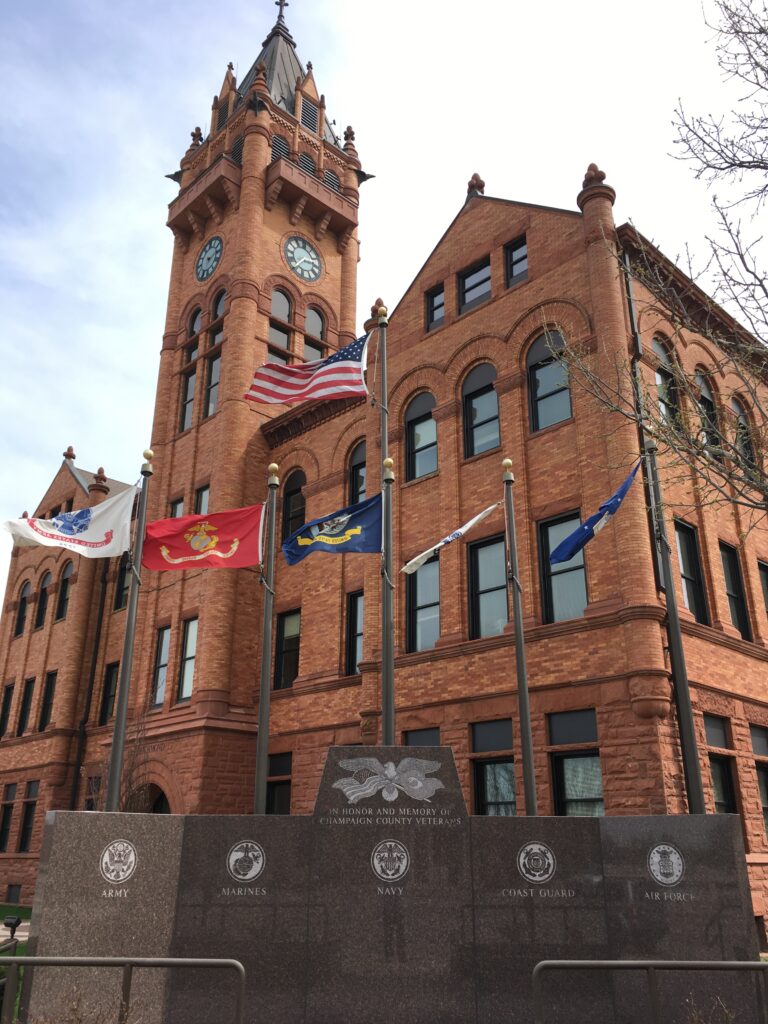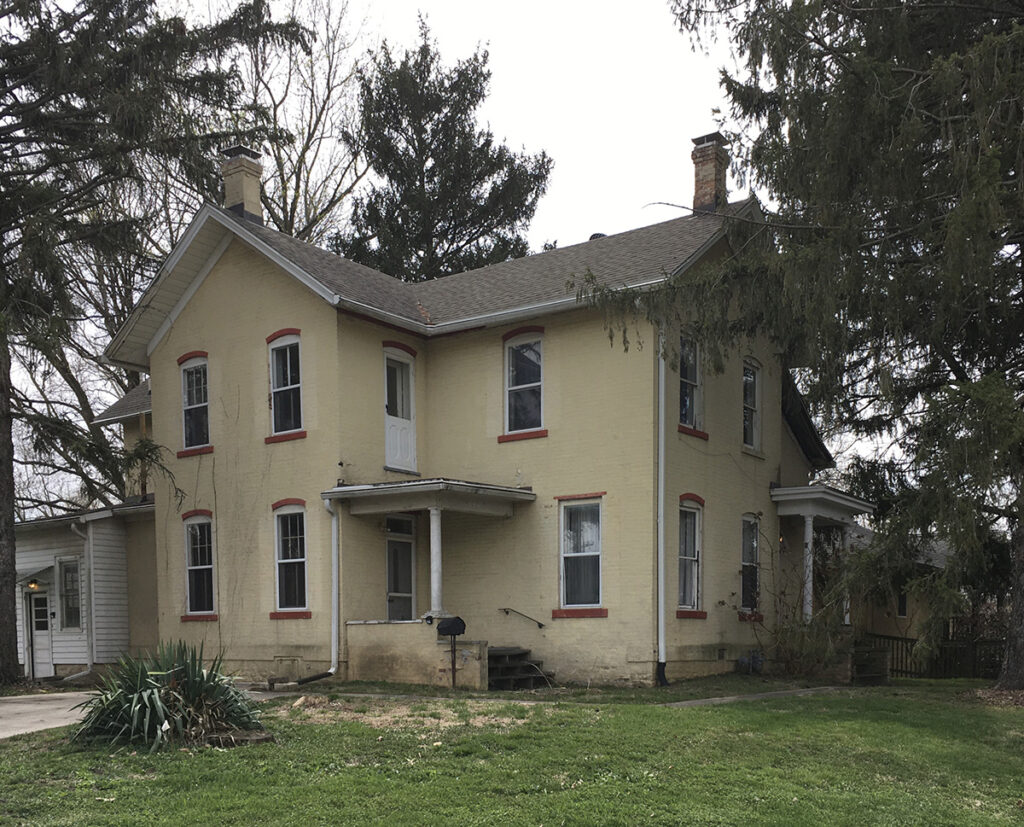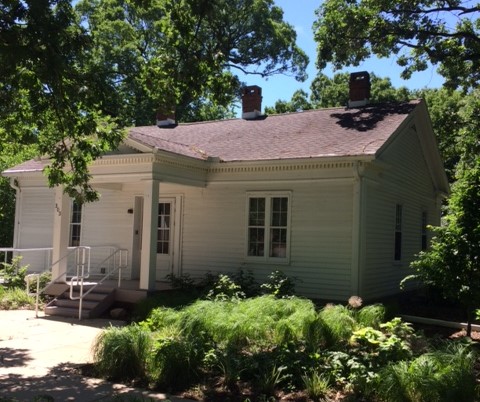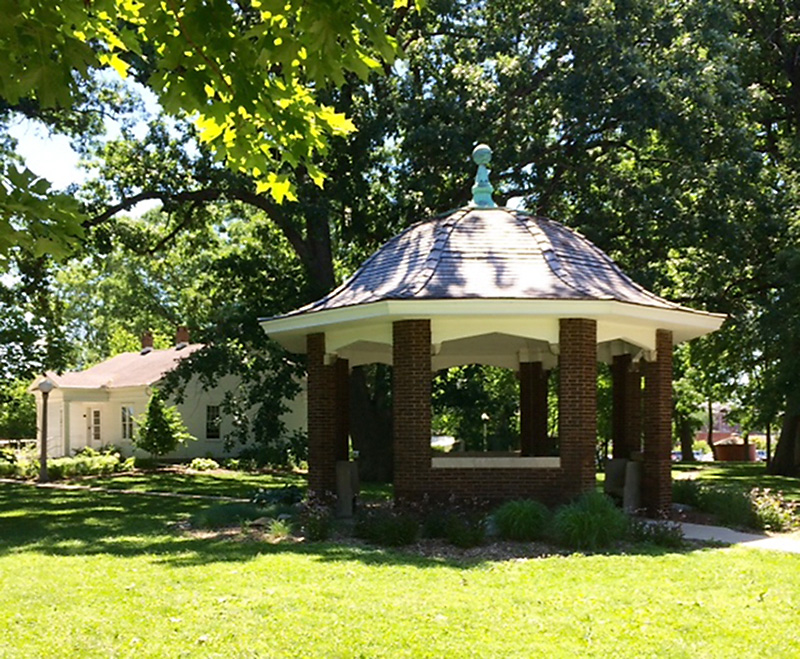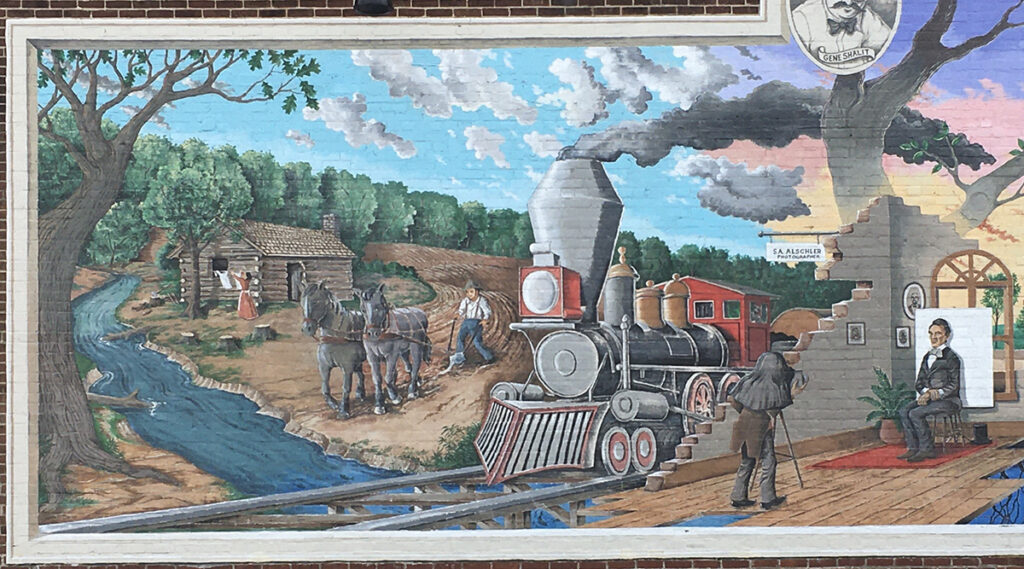
The next time you have a chance to stop in at the Courier Cafe, take a moment in the parking lot to glance down at the creek and imagine yourself standing near the spot where Champaign County began.
In this episode of “Historic Sites Re-visited,” we track down a few spots connected to founding and early development of Urbana, the seat of our fine county. The places and people in this story were first highlighted in a 1976 booklet, Historic Sites of Champaign County, our guide for this virtual tour.
Northwest of the Courier Building (111 N. Race), along the Boneyard Creek, the William Tomkins Cabin (Historic Site #38) once stood. Tompkins built a log cabin on this site in 1822 in what was then western Vermillion County. As did many early arrivals, Tompkins initially “squatted” on the land, finally entering an 80-acre tract in 1830. Later that same year, he sold the property to Isaac Busey and moved on.
Three years later, Champaign County was organized. Busey found himself entertaining two commissioners sent by the Illinois General Assembly to establish the seat of government for the new county. An existing small settlement farther north in the Big Grove, along the old Ft. Clark (later Bloomington) Road, was the most likely location to be selected. The Van Buren Post Office had already been established in the area.
Busey’s property at the south end of the Big Grove was less developed, but his persuasive hospitality, legendarily attributed to generous amounts of whiskey, won the day. A public square was struck off a stone’s throw east of the cabin, streets and lots were laid out, and the town of Urbana became our county seat in 1833.
When journalist, judge, and later county historian J. O. Cunningham arrived in the mid-1850s, the cabin still stood and was described as “the oldest building in town.” Cunningham identified its location in his 1905 History of Champaign County as “close by the flour mill Eli Halberstadt built in 1866.” The long-gone cabin is commemorated, along with other iconic historical images, as part of a fanciful mural painted on the north side of the Courier Cafe in 2016 by artist Glen C. Davies (title picture above).
Judge Cunningham came to Urbana from New York in 1853. He purchased the Urbana Union, making him, according to a biography, “the only Republican and abolitionist editor south of Kankakee” at the time. After being admitted to the bar in 1859, he was elected county judge in 1861. Cunningham’s expansive and elegant mansion north of Urbana (Historic Site #35) was given to the Women’s Home Missionary Society of the Methodist Episcopal Church in 1894 and became Cunningham Children’s Home. It was torn down in the 1920s when the campus was modernized.
The Champaign County Courthouse is Historic Site #37. Court initially was held in Isaac Busey’s cabin, then another small log building was used from 1836-39. Court proceedings took place in local homes or businesses until “a one story wood building forty feet long and 20 feet wide” was built in the public square in 1841 (Cunningham’s History). This structure served dual purposes as a court and schoolroom until it was replaced in 1849.
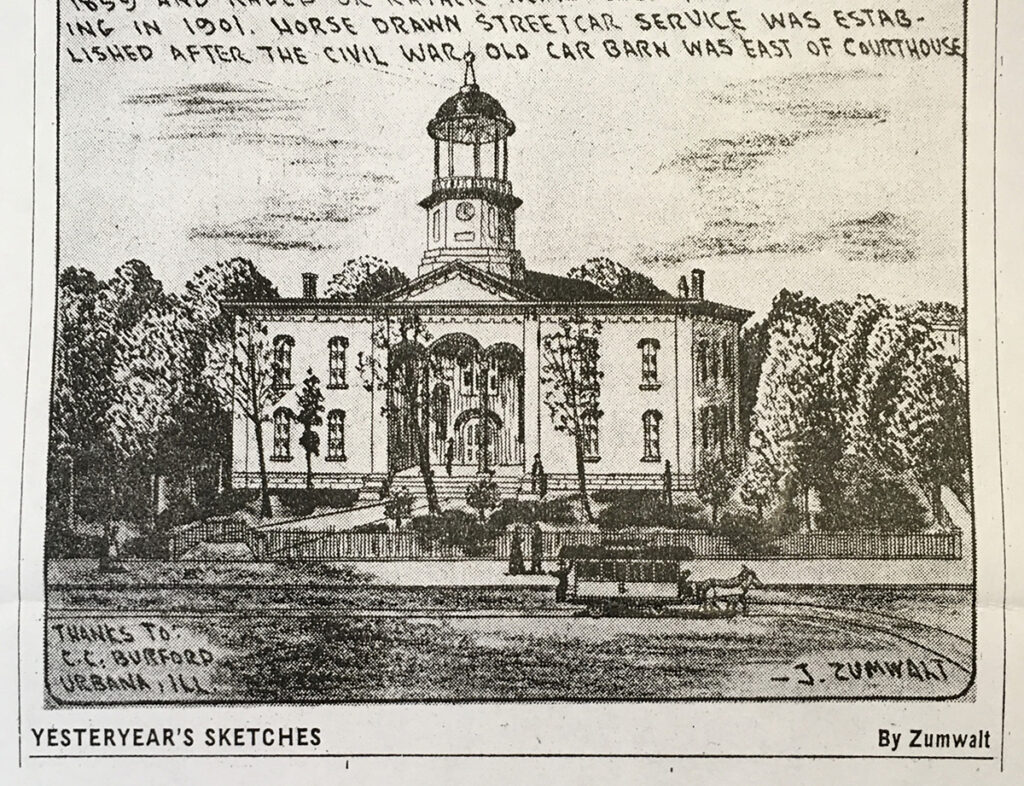
The 1849 building was the first to have a more familiar “institutional” courthouse look of the 19th Century, being “two stories of brick and wood construction with a center bell tower.” Cunningham wrote in his History that this building “gave place…to the third permanent house of the county.” The Historic Sites book says the 1849 structure “was remodeled and enlarged” so that “the altered structure was generally recognized” as an entirely new building.
Finally we come to the origins of the present courthouse, designed in 1901 by noted architect Joseph W. Royer “in a Romanesque Revival style with a central tower and carved sandstone ornament.” Its 135-foot-tall tower was damaged by a lightning strike in 1952, causing the removal of the top 50 feet.
A community fund-raising effort in the mid-2000s led to the restoration of the original clock tower, dedicated in 2009. Learn more about Courthouse history and design here.
.
William T. Webber arrived in Urbana from Kentucky 1832. He purchased 640 acres of land in what eventually became Urbana Township. Some of this land, along with property owned by Isaac Busey, was donated for the location of the new county seat. Son George G. Webber built a house on the family farm in the 1850s. The Webber House (Historic Site #36, now 605 E. Main), “built of brick in the strongly planar style common at the time,” was still occupied by members of the Webber family when the Historic Sites booklet was published in 1976. It still stands today (pictured below) on the south side of what was once the Ft. Clark/Bloomington Road, which had been relocated to a more southerly route after Urbana became the county seat.
According to an online biography, George Webber was among the “foremost of our farmers and stock raisers” in the area. He and Judge Cunningham must have been polar cultural opposites, reflecting the broader realities of antebellum Illinois. Like most early settlers from southern states, Webber was “a democrat of stalwart principles” (which also meant, for many such folk, he was pro-slavery). He was also “of the Universalist faith,” a stark contrast to Cunningham’s more traditional Methodism.
We finish this tour just north of where we began, at Leal Park (Historic Site #39). This land was the first cemetery in Urbana, and perhaps even before that a burial ground for the Pottawatomie Indians encountered by early settlers. The first recorded interment was for Sara Busey (wife of Isaac) in 1833, the same year as our county’s birth. Another notable figure, Pottawatomie sojourner “Chief Shemanger,” was buried here in 1850.
The so-called “Old Urbana Cemetery” was never platted as such. Burials were unorganized and more a matter of necessity than a setting for dignified rest. Burials ended at the turn of the century, and in 1902 marked graves were transferred to Mt. Hope Cemetery. The following year, the Busey family deeded the land to the city for use as a park.
Urbana’s pioneer origins and modern history connect at Leal Park. When the Urbana Park District was organized in 1907, this location, named in honor of County Superintendent of Schools Thomas R. Leal, became Urbana’s first official park. The brick gazebo here was built in 1941 (above right). In 1976 a Greek Revival Cottage (above left) dating to the 1850s and originally located at 1205 West Springfield, was relocated here, but not quite in time to be pictured in the Historic Sites booklet.
Next time, we will head west on Main Street from downtown Urbana to find a trio of beautifully preserved Victorian and Queen Anne residences. Across the street from them sits an even older neighborhood landmark tied to the man who brought the State University to Urbana. We will also discover another Cunningham contribution to local history as we go looking for Lincoln.
Originally featured in the Smile Politely online magazine (April 28, 2020).

